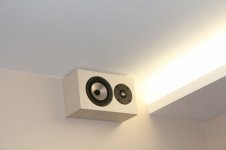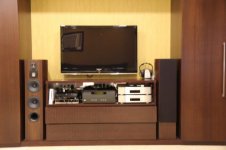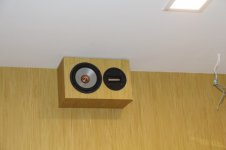If you look up 'passivation of magnesium alloys' you will find that chlorine is the main target of efforts to protect magnesium. So apparently the sea air is your culprit. So we need a mild reducing agent that is water-soluble so as not to attack the surround or adhesive. I'm looking at hydroquinone, used in silver-salt photography, cosmetics, and metalworking. It's fairly easy to get, not an irritant, I just need to work out the right concentration for magnesium. There are several autobody rust converters which use hydroquinone, but varnishes and non-aqueous solvents are present. Since you have replaced them it's not a rush job, I'll get to it before spring.
So don't worry about being able to use them, they'll just never look as good as they sound.
keep the chin up, David
So don't worry about being able to use them, they'll just never look as good as they sound.
keep the chin up, David
Whenever I build speakers a large part of the satisfaction of building them is looking at them as well as listening to them. I couldn't stand to see them in that state. What a pity for such nice drivers to end up that way. Personally I would have to replace them. Does the owner have corrosion problems with any other items in the house? I've lived in high salt areas all my life and had TV antennas disintegrate but I've never had any corrosion issues with speakers or anything else inside the house for that matter. I think the drivers themselves are more to blame than the conditions they are subjected to.
Yess that is dissapointing.
That said: Clearly time to buy New drivers.
This time... ones less susceptible to a salt atmosphere
Whenever I build speakers a large part of the satisfaction of building them is looking at them as well as listening to them...I think the drivers themselves are more to blame than the conditions they are subjected to.
I did reply to this that, if corrosion will occur in damp climates, then the ethical thing to do would be to add a warning on their website about magnesium drivers. I did not receive a reply.
Regards,
John
In 2012 I purchased 9 Magnesium Excel drivers (4 W22, 2 W18, 2 W15, and 1 W12) for the front and center of my home theater system.
All 9 show some degree of oxidation. The choices are:
a. Buy 9 more Magnesium drivers
b. Redesign the crossover and maybe using a different port length (tuning) retune the box to accept Nextel drivers.
The W22 and W18 are used for front and center bass AND the W15 and W12 are used for front and center mids respectively.
Which option is preferable? How much a redesign would moving from Magnesium to Nextel entail. The Nextel drivers are about 1-2db more sensitive but the W22NY woofer will not go as low as the W22EX woofer in the same box (about 42 liters per woofer) no matter what the tuning (even if I use Extended Bass Shelf).
I am not worried about the low bass (sub 100hz) bass response of the center speaker (W18).
The tweeters are Fountek Neo 3.0 for the front and CD 2.0 for the center if I remember right.
Attachments
-
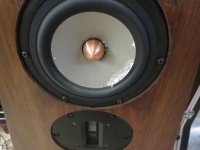 IMG_2528.jpg420.5 KB · Views: 482
IMG_2528.jpg420.5 KB · Views: 482 -
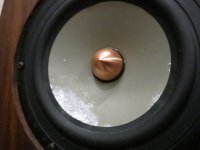 IMG_2535.jpg363.7 KB · Views: 181
IMG_2535.jpg363.7 KB · Views: 181 -
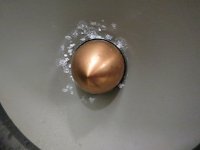 IMG_2534.jpg403.1 KB · Views: 244
IMG_2534.jpg403.1 KB · Views: 244 -
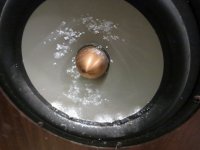 IMG_2533.jpg407 KB · Views: 420
IMG_2533.jpg407 KB · Views: 420 -
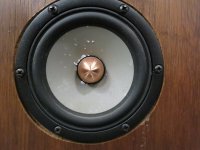 IMG_2532.jpg530.8 KB · Views: 438
IMG_2532.jpg530.8 KB · Views: 438 -
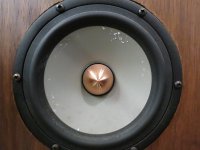 IMG_2531.jpg465.1 KB · Views: 445
IMG_2531.jpg465.1 KB · Views: 445 -
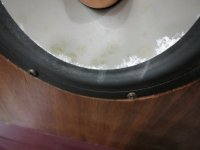 IMG_2530.jpg442.1 KB · Views: 437
IMG_2530.jpg442.1 KB · Views: 437 -
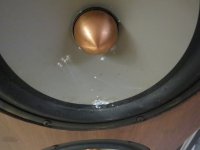 IMG_2529.jpg374.8 KB · Views: 456
IMG_2529.jpg374.8 KB · Views: 456 -
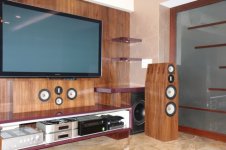 front living room.jpg47.9 KB · Views: 227
front living room.jpg47.9 KB · Views: 227
That's disgusting and shouldn't happen on these expensive drivers. SEAS needs a blast. I'd be spewing. 
I certainly wouldn't be using the Magnesium drivers again but the Nextel could be a good option but I'm sure there would be a lot of tweaking required. A cheaper option would be SEAS CA range but the sonics would drop.
Nice setup BTW.
I certainly wouldn't be using the Magnesium drivers again but the Nextel could be a good option but I'm sure there would be a lot of tweaking required. A cheaper option would be SEAS CA range but the sonics would drop.
Nice setup BTW.
That's disgusting and shouldn't happen on these expensive drivers. SEAS needs a blast. I'd be spewing.
Nice setup BTW.
Thanks. These are pics of the rear speakers and my bedroom system as well (when they were first built in 2012).
I should check the rear speakers in my bedroom too.
A redesign to Nextel drivers will be significant. The Nextel drivers are a bit different in frequency response and sensitivity so the crossovers will have to very different.
In addition the bass alignment of the 8" woofers in the front speakers would have to be changed.
I have invested a lot of time and energy into building these boxes (including matching the veneer to the veneer used in the room) and would not be able to rebuild new boxes with matching veneer. Hence I would at the least like to retain the cabinets.
Attachments
If you're running ribbons I'd be inclined to shift to the nextel units. Most ribbons aren't ideal for lower crossover frequencies as distortion tends to rocket while the magnesium cone Excel drivers really shouldn't be taken too high for best performance. The W18 for e.g. (IMO) is about on the limit by ~1.5KHz - 1.6KHz or you'll run into issues with the 3rd harmonic of the cone's main mode. The nextel units technically aren't quite as capable if used right, but aren't far off & are probably better suited to being partnered with those Fountek ribbons.
In 2012 I purchased 9 Magnesium Excel drivers (4 W22, 2 W18, 2 W15, and 1 W12) for the front and center of my home theater system.
All 9 show some degree of oxidation. The choices are:
I'd use 4 x U22, 2 x ER18, 2 x L16 and 1 x L12 instead Mg.
L12 is the only one that can not really replace W12 version distortion wise but everything else is close enough. Other are all high value versions. They incorporate low distortion motors from Excel series but without Mg membrane and thus without any oxydation problems in the future. And they fit in your predrilled holes.
Last edited:
Thank you guys. The big reason I chose the Excel Magnesium drivers was that I heard a friend's Joesph Audio Pearl and loved the sound (although he was using a turntable and fancy expensive pre amp and power amps).
I don't know what the crossover points are. I did not design the crossover but I believe that the W15 and W12 can run a lot higher than the W18 Magnesium cone can.
My Towers are the following:
W22EX x 2
W15CY
Fountek Neo X3.0
The Center is the following:
W18EX x 2
W12CY
Fountek Neo CD 2.0
I thought the Nextel drivers also incorporate the same motors as the Magnesium Excels.
That said I have used the L15 for a on wall rear speaker and am happy with it and the U22, ER18, L16 and L12 are a lot cheaper than either of the the Excel (Magnesium or Nextel) drivers.
If you're running ribbons I'd be inclined to shift to the nextel units. The W18 for e.g. (IMO) is about on the limit by ~1.5KHz - 1.6KHz or you'll run into issues with the 3rd harmonic of the cone's main mode. The nextel units technically aren't quite as capable if used right, but aren't far off & are probably better suited to being partnered with those Fountek ribbons.
I don't know what the crossover points are. I did not design the crossover but I believe that the W15 and W12 can run a lot higher than the W18 Magnesium cone can.
My Towers are the following:
W22EX x 2
W15CY
Fountek Neo X3.0
The Center is the following:
W18EX x 2
W12CY
Fountek Neo CD 2.0
I'd use 4 x U22, 2 x ER18, 2 x L16 and 1 x L12 instead Mg..
I thought the Nextel drivers also incorporate the same motors as the Magnesium Excels.
That said I have used the L15 for a on wall rear speaker and am happy with it and the U22, ER18, L16 and L12 are a lot cheaper than either of the the Excel (Magnesium or Nextel) drivers.
...I thought the Nextel drivers also incorporate the same motors as the Magnesium Excels.
That said I have used the L15 for a on wall rear speaker and am happy with it and the U22, ER18, L16 and L12 are a lot cheaper than either of the the Excel (Magnesium or Nextel) drivers.
They do but the price tag on Nextel is ludicrous. U22 Sigfried Linkwitz uses in LX521, L16RNX is used by Kii3 (this is yet to be proven), ER18 is used by Zaph in his SR71 - so drivers itself will not be the weak link in the system.
They do but the price tag on Nextel is ludicrous. U22 Sigfried Linkwitz uses in LX521, L16RNX is used by Kii3 (this is yet to be proven), ER18 is used by Zaph in his SR71 - so drivers itself will not be the weak link in the system.
I agree. The Excel units (both Magnesium and Nextel) are both very expensive. I am a bit miffed that SEAS did not coat them well enough for humid costal environments (given that so much of the world's population lives along the coasts). Then again I have a friend who bought a pair of Martin-Logans and thanks to the dusty environment we live in has to keep them covered when not in use.
If SEAS could assure me that this would not re-occur I would be tempted to get a fresh set of Magnesium cones just because they look so lovely. It is with a heavy heart that I am even considering alternated (be it Nextel or Aluminum).
I thought about Mg corrosion with Seas drivers. In my opinion it would need additional and unconventional care. I'm thinking about some liquid wax that is used for cars - sprayed on the cone. It would not add to the cone mass, it is clear coat so it would look good. There is some stuff guys here use with very expensive cars - wax that is activated by heat of hands and when applied it cools and hardens. If it's good enough for a Lambo, it could be good for Seas 
If you're running ribbons I'd be inclined to shift to the nextel units.
Thanks.
My Towers are the following:
W22EX x 2, W15CY, Fountek Neo X3.0
The Center is the following:
W18EX x 2, W12CY, Fountek Neo CD 2.0
Hence the crossover between is between a smaller mid-woofer and Fountek ribbon and the W15 and w12 can easily go to 3000Hz.
I thought about Mg corrosion with Seas drivers. In my opinion it would need additional and unconventional care. I'm thinking about some liquid wax that is used for cars - sprayed on the cone. It would not add to the cone mass, it is clear coat so it would look good. ...If it's good enough for a Lambo, it could be good for Seas
Good Idea. It would be nice if SEAS could verify this.
Do you have any details on the type of clear coat that can be used?
Thanks.
Hello,
I started this thread with the corrosion on the W12s of a pair of speakers I had made for a customer. I decided to replace the W12s with L12s, as I thought that being aluminium cones, they would be more resistant to corrosion and that seems to have been the case. There may have been some modest loss of quality but I needed the speakers to be reliable. That left me with a pair of W12s with corrosion. Rather than throw them out, I cleaned off the corrosion as thoroughly as I could and then I sprayed the cones black and put them into a pair of speakers I made for my son with a Bluetooth amplifier and rechargeable battery pack from Dayton.They seem to have held together well. My assumption was that there was a protective coating on the W12s which was inadequately applied and I needed to apply a protective coating of my own. I hope this is helpful.
I started this thread with the corrosion on the W12s of a pair of speakers I had made for a customer. I decided to replace the W12s with L12s, as I thought that being aluminium cones, they would be more resistant to corrosion and that seems to have been the case. There may have been some modest loss of quality but I needed the speakers to be reliable. That left me with a pair of W12s with corrosion. Rather than throw them out, I cleaned off the corrosion as thoroughly as I could and then I sprayed the cones black and put them into a pair of speakers I made for my son with a Bluetooth amplifier and rechargeable battery pack from Dayton.They seem to have held together well. My assumption was that there was a protective coating on the W12s which was inadequately applied and I needed to apply a protective coating of my own. I hope this is helpful.
Pure magnesium has terrible corrosion resistance, that's one of the reasons it is typically alloyed with aluminium. I wonder if the adhesive used to attach the cone to the former and surround accelerates corrosion, since in the pictures in this thread the corrosion seems to be more severe in those areas. They may also off-gas in hot climates.
As with a lot of drivers, it seems that they unfortunately just picked the material for the cone arbitrarily because it seemed exotic, instead of applying materials engineering. Annodised aluminium performs almost identically and is much more stable.
Automotive wax or silicone spray can be used to protect magnesium cones.
As with a lot of drivers, it seems that they unfortunately just picked the material for the cone arbitrarily because it seemed exotic, instead of applying materials engineering. Annodised aluminium performs almost identically and is much more stable.
Automotive wax or silicone spray can be used to protect magnesium cones.
Last edited:
Good Idea. It would be nice if SEAS could verify this.
Do you have any details on the type of clear coat that can be used?
Thanks.
I doubt that Seas can verify anything about this.
I'm going by logic that salt and minerals that stick to the car ruins the paint job and waxes serve as an isolation from external conditions but without loosing any shine of the factory color.
I'm not into that business but i knew a guy who did only car polishing for extra expensive vehicles. He told me what i told you, so i guess that you can find out more on the subject on car forums than from me at this point.
Automotive 'wax' makes water bead instead of pool (hydrophobic), which makes it run off surfaces more easily instead of forming pools of standing water. The water running off onto the ground transports contaminants to the ground which would otherwise be suspended in pools of water, which would dry on the painted surface and result in unsightly water spots. Contaminants don't like sticking to a waxed surface either, so next time the car is washed they can be removed with less aggressive scrubbing methods, preventing scratching the paint during cleaning. Automotive paint is just plastic so it won't degrade quickly when exposed to moist conditions. Extremely acidic liquids (e.g. bird poo) can attack it (or slightly acidic liquid over a long period e.g. a damp car cover), but other than that it mostly degrades due to UV exposure. Contrary to popular belief the paint on a car will stay in excellent condition as long as you keep it out of harsh sunlight, clean off highly acidic substances promptly and prevent grinding dirt into it when you wash it.
We don't need to worry much about cleaning dirt from a magnesium cone so the above properties of wax don't help us much. What does make wax useful is that since it is hydrophobic, it provides a moisture barrier and after applying and buffing it off it is 'dry' so it won't attract dust. Silicone based sprays are also 'dry' and make water bead so they accomplish the same thing. Automotive 'wax' is typically not silicone based because silicone leeches into the paint finish and makes repainting a panel a nightmare since the new paint doesn't want to adhere.
Oil would serve as a moisture barrier but it remains wet and greasy so it attracts dust. Many oils (mostly petroleum based) will also dissolve plastic and rubber parts, adhesives.
Automotive wax or silicone based sprays (for lubricating plastic parts or for spraying on interiors to make them darker/blacker) should be reasonably safe for rubber if used sparingly.
We don't need to worry much about cleaning dirt from a magnesium cone so the above properties of wax don't help us much. What does make wax useful is that since it is hydrophobic, it provides a moisture barrier and after applying and buffing it off it is 'dry' so it won't attract dust. Silicone based sprays are also 'dry' and make water bead so they accomplish the same thing. Automotive 'wax' is typically not silicone based because silicone leeches into the paint finish and makes repainting a panel a nightmare since the new paint doesn't want to adhere.
Oil would serve as a moisture barrier but it remains wet and greasy so it attracts dust. Many oils (mostly petroleum based) will also dissolve plastic and rubber parts, adhesives.
Automotive wax or silicone based sprays (for lubricating plastic parts or for spraying on interiors to make them darker/blacker) should be reasonably safe for rubber if used sparingly.
Last edited:
Maybe renaissance wax would be a good product to use for these cones?
I use it for wood and metal myself, and like it very much, does smell for a few hours after applying though.
Renaissance Wax
I have a pair of W17 that have not been used, they show no sign of corrosion.
(I have not used any products on them)
I use it for wood and metal myself, and like it very much, does smell for a few hours after applying though.
Renaissance Wax
I have a pair of W17 that have not been used, they show no sign of corrosion.
(I have not used any products on them)
Firstly a BIG thank you to everyone.
This is indeed very helpful - it gives me even more confidence in looking for a suitable clear coat that will go on very, very, thin and dry fast (preferably on contact). I have already left a message for the local 3M dealer (in India) and I hope he does return my call.
Thank you for the detailed explanation. A silicone spray might be easier to apply. Is there a brand or type that you can recommend.
Thanks. I did contact the local Super-Car chapter (Ferraris, Lamborghinis, and other exotics) and got recommendations for everything from protection film to wax to ceramics.
What do you recommend for the Magnesium cone?
Hmm...lets see. First I need to be sure if I can protect the second lot of Excel drivers.
Is this wax that can be applied lightly. I do NOT want to increase cone mass too much as that will change all the T/S parameters of the driver.
Thanks Again everyone for the advice and support.
My line of action is as follows:
1. first find an assured method for protecting the Magnesium cones. If I can do this I can order a fresh set of Excel drivers and hope to get some discount. I live in India and I don't know anyone at SEAS so I expect any discount to be a long shot.
2. If the above does not work then I can have the choice of redesigning the speaker using Aluminum or Nextel drivers and trying to retain the cabinet (same baffle, same diameter and mounting dimensions for the driver, etc.) using maybe a different bass tuning. I do not know what this entails and what degree of cooperation I can receive from SEAS for this.
Rather than throw them out, I cleaned off the corrosion as thoroughly as I could and then I sprayed the cones black and put them into a pair of speakers I made for my son with a Bluetooth amplifier and rechargeable battery pack from Dayton.They seem to have held together well. My assumption was that there was a protective coating on the W12s which was inadequately applied and I needed to apply a protective coating of my own. I hope this is helpful.
This is indeed very helpful - it gives me even more confidence in looking for a suitable clear coat that will go on very, very, thin and dry fast (preferably on contact). I have already left a message for the local 3M dealer (in India) and I hope he does return my call.
Annodised aluminium performs almost identically and is much more stable.
Automotive wax or silicone spray can be used to protect magnesium cones.
Thank you for the detailed explanation. A silicone spray might be easier to apply. Is there a brand or type that you can recommend.
I'm not into that business but i knew a guy who did only car polishing for extra expensive vehicles. He told me what i told you, so i guess that you can find out more on the subject on car forums than from me at this point.
Thanks. I did contact the local Super-Car chapter (Ferraris, Lamborghinis, and other exotics) and got recommendations for everything from protection film to wax to ceramics.
Automotive wax or silicone based sprays (for lubricating plastic parts or for spraying on interiors to make them darker/blacker) should be reasonably safe for rubber if used sparingly.
What do you recommend for the Magnesium cone?
Is it worth getting in touch with SEAS and at least get a good discount on the next bunch of Excels?
Hmm...lets see. First I need to be sure if I can protect the second lot of Excel drivers.
Maybe renaissance wax would be a good product to use for these cones?
Is this wax that can be applied lightly. I do NOT want to increase cone mass too much as that will change all the T/S parameters of the driver.
Thanks Again everyone for the advice and support.
My line of action is as follows:
1. first find an assured method for protecting the Magnesium cones. If I can do this I can order a fresh set of Excel drivers and hope to get some discount. I live in India and I don't know anyone at SEAS so I expect any discount to be a long shot.
2. If the above does not work then I can have the choice of redesigning the speaker using Aluminum or Nextel drivers and trying to retain the cabinet (same baffle, same diameter and mounting dimensions for the driver, etc.) using maybe a different bass tuning. I do not know what this entails and what degree of cooperation I can receive from SEAS for this.
Last edited:
- Home
- Loudspeakers
- Multi-Way
- Corrosion SEAS Magnesium Drivers
